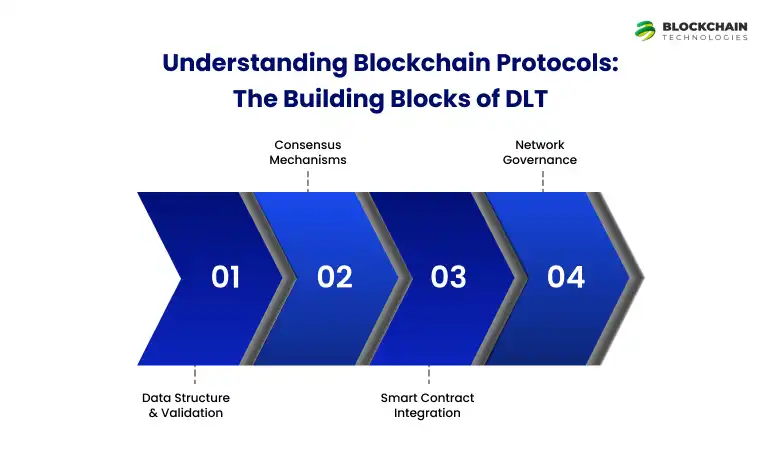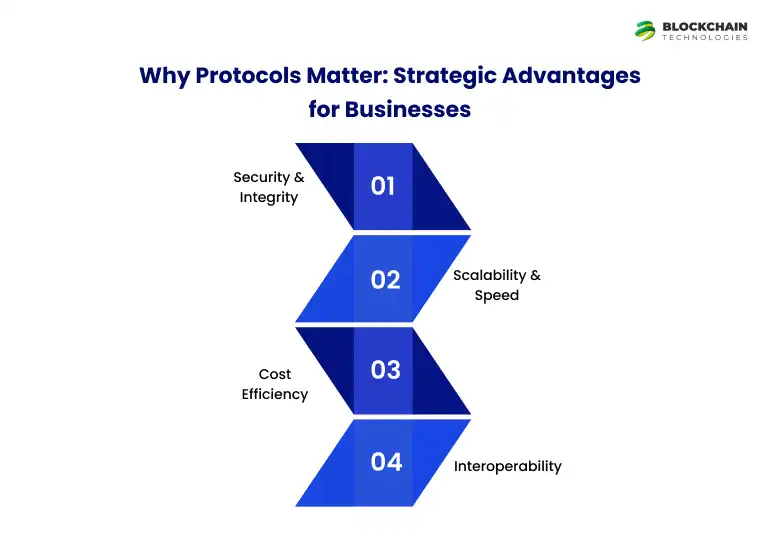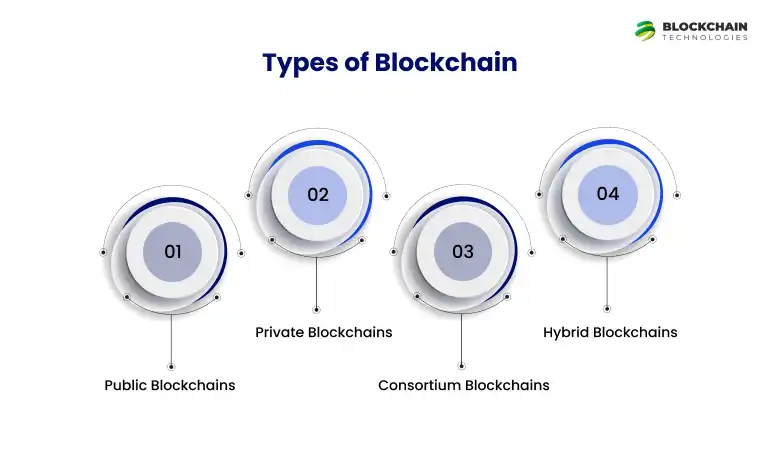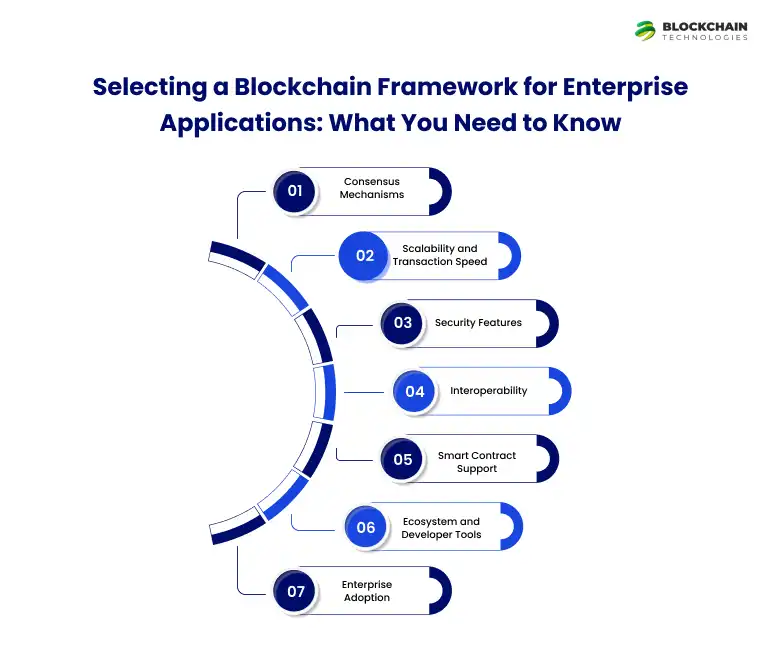Comparing Blockchain Protocols: Choosing the Right Platform for Your Project
May 29,2025

In 2025, the blockchain landscape is more dynamic than ever. From finance and banking to healthcare and global supply chains, organizations are integrating decentralized technology and distributed ledger technology (DLT) to transform data security, operational transparency, and transaction efficiency.
With over $51.9 trillion in value locked in smart contracts and more than 84% of global enterprises actively exploring or deploying blockchain solutions, it’s clear that blockchain protocols have evolved far beyond cryptocurrency hype.
So, if you’re a startup seeking scalability or an enterprise prioritizing security, understanding the core differences among blockchain platforms can directly impact your project’s long-term success.
Take healthcare providers, for example. They are increasingly adopting blockchain protocols to secure electronic medical records while enabling patient-centric data access. Similarly, global supply chains are tapping into DLT for transparent and tamper-proof product traceability. Clearly, the right blockchain protocol is actually a strategic business move.
But with hundreds of blockchain frameworks available, each offering different comparing consensus mechanisms in blockchain protocols, smart contract capabilities, scalability features, and interoperability layers, choosing the best-fit protocol can be overwhelming.
This Comprehensive Guide Will Help You Explore:
- 1. What Are Blockchain Protocols and Why Do They Matter in Decentralized Systems
- 2. Detailed Comparison of Various Blockchain Networks
- 3. How to Choose a Blockchain Platform for Your Business
What Are Blockchain Protocols? Understanding the Fundamentals
Blockchain protocols are the foundational rules that govern how data is recorded, validated, and shared across a decentralized network. They enable secure, scalable, and interoperable blockchain platforms by defining consensus mechanisms, data structures, and smart contract functionalities.
But what exactly are they, and why Blockchain protocols needed for startups, enterprises, and developers?
What Makes Blockchain Protocols So Important?
So, whether you’re building a smart contract platform, a decentralized finance app, or a supply chain solution powered by distributed ledger technology (DLT), the protocol you choose determines the rules of engagement, how data is verified, how participants reach consensus, and how secure or scalable your application will be.
These protocols are the backbone of decentralized technology, shaping everything from interoperability to security features.
Understanding Blockchain Protocols: The Building Blocks of DLT
Here’s a simplified breakdown of what blockchain protocols enable:

- Data Structure & Validation Protocols define how transactions are recorded on the blockchain. For instance, Bitcoin uses the UTXO model, while Ethereum relies on an account-based model.
- Consensus Mechanisms From Proof of Work (PoW) to Proof of Stake (PoS), and Byzantine Fault Tolerance (BFT), protocols dictate how nodes agree on data validity without central authority. This ensures secure and scalable blockchain platforms for startups and enterprises alike.
- Smart Contract Integration Some protocols, like Ethereum and Solana, offer native smart contract platforms, making it easier to build decentralized apps (dApps) with programmable logic.
- Network Governance Protocols also define how upgrades, voting, and community decisions are handled—critical for maintaining trust in a decentralized ecosystem.
Why Protocols Matter: Strategic Advantages for Businesses

- Security & Integrity Choosing the right protocol can safeguard against attacks and ensure tamper-proof transaction validation, especially vital in enterprise blockchain solutions.
- Scalability & Speed Some protocols offer better throughput (transactions per second), which is essential when evaluating scalability in blockchain for high-volume applications.
- Cost Efficiency Protocols influence gas fees and resource consumption, key factors for startups with limited budgets seeking the best blockchain protocol for enterprise projects.
- Interoperability Platforms like Polkadot and Cosmos are built for cross-chain compatibility, addressing the growing need for interoperability solutions among blockchain networks.
Overwhelmed by Blockchain Choices?
Simplify the selection process and gain clarity on the best protocol for your project.
Types of Blockchain:

Choosing the top blockchain frameworks starts with understanding its type. By understanding these blockchain types, you’re better equipped to answer the big question:
“How to choose the right blockchain protocol for your project?”
Let’s break down the four major types of blockchain with real-world use cases and technical highlights.
Public Blockchains:
Public blockchains like Ethereum and Bitcoin are permissionless, allowing anyone to participate in the network. They rely on decentralized technology and consensus mechanisms like Proof of Work (PoW) or Proof of Stake (PoS) to validate transactions.
Key Features:
- Fully decentralized with no central authority
- Ideal for smart contract platforms and token economies
- High transparency and auditability
- Slower performance due to scalability challenges in blockchain networks
Private Blockchains:
Private blockchains are permissioned networks controlled by a single organization. Platforms like Hyperledger Fabric offer high performance and are tailored for enterprise blockchain solutions in sectors like healthcare, banking, and supply chains.
Key Features:
- Faster transaction speeds and higher throughput
- Fine-grained access control and confidentiality
- Used in secure and scalable blockchain platforms for startups and enterprises
- Less decentralized, more centralized governance
Consortium Blockchains:
Consortium blockchains are partially decentralized and governed by a group of trusted entities. These are widely adopted in sectors like finance, insurance, and global supply chains, offering a balance between decentralization and control.
Key Features:
- Joint governance from multiple stakeholders
- Efficient collaboration and data sharing
- Enhanced blockchain interoperability
- Moderate privacy and scalability
Hybrid Blockchains:
Hybrid blockchains combine elements of public and private blockchains, enabling customizable access controls. They are perfect for companies needing transparency for some operations and privacy for others.
Key Features:
- Selective data exposure - public and private elements coexist
- Great for supply chain traceability with secure internal processes
- Customizable for regulatory and enterprise needs
Blockchain Type Comparison
This comparison will help you understand the differences between blockchain frameworks and decide how to choose the right blockchain protocol for your project, whether you’re focusing on enterprise blockchain solutions or decentralized technology.
| Type of Blockchain | Access Level | Transparency | Best For |
|---|---|---|---|
| Public Blockchain | Open to all | High (Fully Public) | Cryptocurrencies, public dApps, smart contract platforms (e.g., Ethereum, Bitcoin) |
| Private Blockchain | Restricted (Permissioned) | Low (Internal only) | Internal enterprise systems, healthcare data sharing, private finance |
| Consortium Blockchain | Limited to selected orgs | Moderate | Banking consortia, supply chain tracking, insurance, enterprise blockchain solutions |
| Hybrid Blockchain | Mix of public & private | Controlled | Government + private collaboration, secure business transactions, IoT |
Key Takeaways:
- Public blockchains are ideal when decentralization and transparency are priorities.
- Private blockchains offer control and performance for sensitive enterprise operations.
- Consortium blockchains strike a balance between trust and efficiency in inter-organizational networks.
- Hybrid blockchains offer the best of both worlds, enabling businesses to customize access and visibility.
Optimize Your Blockchain Implementation
From selection to execution, we’ll ensure your blockchain protocol aligns perfectly with your business goals.
Selecting a Blockchain Framework for Enterprise Applications: What You Need to Know
When conducting a blockchain protocol comparison, it’s essential to evaluate both technical and business criteria. So, if you’re assessing blockchain platforms for a startup or looking into enterprise blockchain solutions, here are the top factors to consider before choosing the right blockchain protocol for your project:

1. Consensus Mechanisms
The method used to validate transactions and maintain agreement across the network.
- Proof of Work (PoW): High security but energy-intensive (e.g., Bitcoin).
- Proof of Stake (PoS): Energy-efficient, faster, and scalable (e.g., Ethereum 2.0).
- Practical Byzantine Fault Tolerance (PBFT): Suitable for permissioned blockchains (e.g., Hyperledger Fabric).
2. Scalability and Transaction Speed
How many transactions per second (TPS) can the network handle?
- Public blockchains like Ethereum have limited TPS unless layer 2 is used.
- Enterprise protocols like Hyperledger or Corda blockchain offer better throughput for business operations.
3. Security Features
Security considerations in blockchain protocol selection, is paramount when handling sensitive data or digital assets.
- Look for features like immutable ledgers, multi-signature, encryption, and smart contract audits.
- Permissioned blockchains often include access controls for internal use.
4. Interoperability
Can the protocol communicate with other blockchain networks?
- Modern protocols like Polkadot, Cosmos, and Stellar network enable cross-chain data transfer.
- Crucial for enterprise systems needing to interact across different blockchain platforms.
5. Smart Contract Support
Does the protocol allow programmable transactions?
- Ethereum, BNB Chain, and Polygon are top smart contract platforms.
- Check for ease of development, programming languages supported (e.g., Solidity, Rust), and tooling.
6. Ecosystem and Developer Tools
A healthy developer community and enterprise support matter.
- Ethereum and Solana have large communities.
- Hyperledger and Corda provide robust SDKs for enterprise app development.
7. Enterprise Adoption
Adoption level reflects maturity and use-case reliability.
- Hyperledger Fabric is widely adopted in healthcare and supply chains.
- Ethereum is dominant in DeFi and NFTs.
- Evaluate based on your vertical: finance, supply chain, healthcare, etc.
Top Blockchain Protocols in 2025
So Everyone Wonders, What is the Best Blockchain Protocol for Enterprises? And Here It Is
Ethereum:
Ethereum is the leading blockchain for smart contracts, supporting decentralized applications (dApps) in sectors like DeFi and NFTs. It is transitioning to Proof of Stake for better scalability and energy efficiency. Ethereum’s ecosystem is robust, making it the go-to choice for developers.
Features:
- Ethereum Virtual Machine (EVM) for seamless dApp development
- DeFi and NFT ecosystems
- Proof of Stake for scalability and sustainability
XDC Network:
XDC combines public and private blockchain features, making it ideal for enterprise blockchain solutions like supply chain management and trade finance. Its focus on low-cost transactions and fast speeds positions it well for business applications.
Features:
- Low-cost, fast transactions
- ISO 20022 compliance for global finance
- Enterprise-focused blockchain solutions
BNB Chain:
BNB Chain, powered by Binance, is an EVM-compatible blockchain known for its high performance, low transaction costs, and massive ecosystem support. It’s ideal for building scalable DeFi apps, NFT platforms, and GameFi projects.
Features:
- EVM compatibility for easy smart contract migration
- Proof of Staked Authority (PoSA) for faster block times
- Strong ecosystem with extensive Binance support
Cardano:
Cardano uses a peer-reviewed academic approach, emphasizing security and scalability with Ouroboros Proof of Stake. It’s ideal for regulated industries like healthcare and finance due to its focus on formal verification and sustainability.
Features:
- Ouroboros Proof of Stake for scalability and security
- Formal verification for regulated industries
- Sustainability-focused development
Polkadot:
Polkadot is built for interoperability, allowing different blockchains to communicate via the Inter-Blockchain Communication (IBC) protocol. Its parachains structure provides scalability and customization for various use cases.
Features:
- Parachains for customizable blockchains
- IBC for cross-chain communication
- Scalable and secure multi-chain architecture
Solana:
Solana is known for its high throughput and low-latency capabilities, supporting more than 65,000 transactions per second (TPS). It’s ideal for DeFi, NFTs, and enterprise-level decentralized applications.
Features:
- Proof of History (PoH) for fast transaction speeds
- 65,000+ TPS for scalability
- Low-cost transactions for high-volume dApps
Stellar:
Stellar is designed for fast, low-cost cross-border payments, using its federated Byzantine agreement (FBA) consensus. It works well with stablecoins, making it an excellent choice for global remittances and payment systems.
Features:
- Fast cross-border payments
- FBA consensus for security and decentralization
- Stablecoin support for financial institutions
Cosmos:
Cosmos enables interoperability between different blockchains using the IBC protocol. It offers a scalable, multi-chain framework, ideal for building decentralized applications that require cross-chain communication.
Features:
- Inter-Blockchain Communication (IBC) for cross-chain interaction
- Tendermint consensus for fast finality
- Cosmos SDK for custom blockchain development
Ripple (XRP Ledger):
Ripple’s XRP Ledger focuses on real-time, low-cost cross-border payments. It uses an RPCA consensus algorithm that provides energy efficiency and quick transaction processing, making it ideal for the global financial system.
Features:
- XRP Ledger for fast settlements
- RPCA consensus for energy-efficient transactions
- Global payment system integration
Avalanche:
Avalanche is designed for sub-second transaction finality and high throughput with its Avalanche consensus protocol. It’s suitable for DeFi applications that require scalability and security.
Features:
- Sub-second transaction finality
- Avalanche consensus for high throughput
- Customizable chains for various dApp use cases
NEAR Protocol:
NEAR Protocol offers linear scalability using Nightshade sharding to ensure fast, low-cost transactions. It’s designed to be developer-friendly with support for Rust and AssemblyScript, making it perfect for Web3 development.
Features:
- Nightshade sharding for linear scalability
- Developer-friendly with Rust and AssemblyScript
- Low-cost transactions for scalable dApps
Top Blockchain Protocol Comparison: Ranking the Best Blockchain Platforms for 2025
So, how to choose the right blockchain protocol for your business. Here’s a comparative overview of the leading blockchain protocols based on key features, performance, and ideal use cases for various industries in 2025.
| Blockchain Protocol | Consensus Mechanism | Speed (TPS) | Main Use Cases | Security Features |
|---|---|---|---|---|
| Ethereum | Proof of Stake (PoS) | 30–100 | DeFi, NFTs, dApps | Smart contract security, dApp integrity |
| XDC Network | Delegated Proof of Stake (DPoS) | 2,000+ | Supply chain, Trade finance | ISO 20022 compliance, privacy focus |
| Cardano | Ouroboros PoS | 250+ | Healthcare, Finance, Education | Formal verification, decentralized security |
| Polkadot | Nominated Proof of Stake (NPoS) | 1,000+ | Cross-chain applications | Parachains, shared security |
| Solana | Proof of History (PoH) | 65,000+ | DeFi, NFTs, Gaming | High throughput, low latency |
| Stellar | Federated Byzantine Agreement (FBA) | 1,000+ | Cross-border payments, Remittances | Efficient, secure transaction processing |
| Cosmos | Tendermint PoS | 1,000+ | Interoperability, Cross-chain dApps | Fast finality, custom security |
| Ripple (XRP Ledger) | RPCA Consensus | 1,500+ | Cross-border payments, Financial settlements | Secure, fast cross-border payments |
| Avalanche | Avalanche Consensus | 4,500+ | DeFi, Finance, NFTs | Customizable chains, fast finality |
| NEAR Protocol | Nightshade Sharding | 100,000+ | Web3, Decentralized apps | Sharding, low-cost transactions |
Get Your Blockchain Strategy Right
Wondering which blockchain protocol fits your goals? Let’s discuss your needs and implement a solution that drives success
Matching Blockchain Protocols to Business Needs
Selecting the right blockchain protocol is all about aligning platform capabilities with your business goals. Let’s explore how specific blockchain platforms serve unique industry needs.
Enterprise Blockchain Solutions:
- Choosing Permissioned Frameworks like Hyperledger Fabric and Corda
- For businesses that prioritize privacy, governance, and regulatory compliance, permissioned blockchain protocols are the go-to.
- Hyperledger Fabric and Corda support complex workflows and are ideal for sectors like banking, insurance, and supply chain.
Decentralized Applications (dApps):
- Building on Ethereum for Smart Contract Flexibility
- When it comes to launching decentralized applications, few platforms rival Ethereum for its developer community and mature infrastructure.
- Its robust smart contract platform enables fast innovation in DeFi, gaming, and NFTs.
Cross-Border Transactions:
- Need instant, low-cost global payments? Stellar's decentralized technology is optimized for remittances and cross-border transactions.
- Its consensus mechanism enables secure transfers without intermediaries.
IoT Integration:
- Leveraging IOTA’s Scalable Architecture for Device Ecosystems
- With billions of connected devices, IoT demands a scalable and lightweight blockchain.
- IOTA’s Tangle architecture eliminates fees and enables fast data exchange across IoT networks.
How to Match Blockchain Protocols with Your Industry Use Case
Selecting the right blockchain protocol involves more than just checking TPS or consensus, it’s about matching the blockchain platform’s technical strengths with your industry-specific challenges. Here’s how you can align blockchain protocols to business needs using real-world applications.
Finance & Banking:
Secure and Scalable Blockchain Platforms for Startups and Enterprises. Blockchain has revolutionized financial services, insurance by enabling real-time settlements, fraud prevention, and cross-border payments.
- Ripple (XRP Ledger) is built for high-speed, low-cost international payments.
- Stellar is ideal for remittances and underbanked populations.
- Ethereum powers a wide range of DeFi platforms, from lending to stablecoins.
Healthcare:
- Cardano is often used for verified digital identities and clinical trials.
- Hyperledger Fabric supports permissioned access and HIPAA compliance.
- NEAR Protocol offers low-cost solutions for dApp-based patient portals.
Supply Chain:
Transparent and Tamper-Proof Tracking with Decentralized Technology. Global supply chains demand traceability, automation, and fraud prevention, all of which blockchain can deliver.
- VeChain specializes in product provenance and logistics.
- XDC Network enables trade finance and real-time tracking of shipping.
- IBM Blockchain (Hyperledger) supports smart contracts for supplier verification.
Real Estate & Asset Tokenization:
Blockchain in real estate with smart Contract Platforms for Trustless Transactions. Tokenizing assets like property or art allows for fractional ownership, liquidity, and automated execution using smart contracts.
- Ethereum remains a stronghold for asset tokenization platforms.
- Avalanche is increasingly used for rapid token settlements and property records.
- Polkadot enables interoperability across asset registries.
Gaming & NFTs:
Scalable and Developer-Friendly Blockchain Frameworks. From NFTs to GameFi, the gaming sector demands high-speed, low-latency, and scalable blockchain platforms.
- Solana handles high TPS for real-time gaming.
- Flow is purpose-built for NFTs with consumer-grade scalability.
- NEAR Protocol ensures low gas fees and ease of smart contract deployment.
Government & Identity Management:
- Corda focuses on enterprise privacy and regulatory compliance.
- Hyperledger Fabric enables private, permissioned networks.
- Cardano supports verifiable IDs and traceable fund distribution.
Wrapping up: Choosing the Right Blockchain Protocol for Your Project
In 2025, the blockchain landscape is more versatile and enterprise-ready than ever before. With innovations in consensus mechanisms, improvements in scalability, and rising enterprise interest in decentralized technology, choosing the right blockchain protocol is a strategic business decision.
So, if you’re building smart contract platforms, developing decentralized applications (dApps), or designing enterprise blockchain solutions, aligning your use case with the right blockchain framework is essential.
So, when evaluating protocols, consider:
- 1. Scalability and throughput
- 2. Consensus mechanism suitability
- 3. EVM compatibility and dApp support
- 4. Ecosystem maturity and developer tools
- 5. Security and compliance features
Still unsure which blockchain fits your needs? It might be time to consult with a top blockchain development company like Blockchaintechs.io to ensure your investment aligns with your enterprise goals or startup scalability strategy.
Make the Smart Choice with Sunrise Technologies
Choosing the right blockchain protocol is key to your success. Partner with Sunrise Technologies for expert guidance tailored to your enterprise needs.
FAQs:
Consider your project’s specific needs, such as scalability, security, and interoperability. Evaluate platforms based on these criteria to find the best fit.
Ethereum is a public blockchain suitable for decentralized applications, while Hyperledger Fabric is a permissioned blockchain designed for enterprise use, offering more control and privacy.
Blockchain app development can range from $5,000 to $100,000+, depending on the protocol and complexity. For a budget-friendly solution, consider BlockchainTechs.io, an affordable blockchain app development company offering tailored, cost-effective services.
Common consensus mechanisms include Proof of Work (PoW), Proof of Stake (PoS), and unique models like IOTA’s Tangle, each affecting performance and security differently.
Interoperability is crucial for integrating blockchain solutions with existing systems and other blockchains, enhancing functionality and user adoption.

